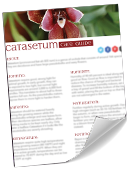Orchid Plant Pollination By Insects
Author: adminNo Comments
Care and Culture, Classification, Propagation
Most orchid flowers are pollinated by insects, some by various kinds of bee and fly and some at night by moths.
Angraecum sesquipedale is one of those fertilized by a moth. This Madagascan species has a spur-like nectary, 12in (30cm) long, below the labellum, and only an insect with a proboscis equally long is capable of pollinating the flower. It was 40 years after Darwin had postulated the existence of such an insect and the process by which the flower was fertilized that his idea was verified by the discovery of just such an insect, a moth, much to the discomfiture of those entomologists who had scoffed at his theory.
In the cattleyas with their flamboyant labellums, the flower is pollinated by a large insect such as a bee which, attracted by the perfume and the honey guides (those lines of contrasting color lead it to the throat of the labellum), lands on the labellum, forces its way towards the nectar and in so doing depresses the labellum and takes its fill f the nectar. In withdrawing the insect backs out, there being insufficient room to turn around, and in so doing removes the pollinia which lodge on its head. The pollinia are placed below the apex of the column by nature for this purpose. On visiting another cattleya flower the bee repeats the routine but this time, on backing out, the pollinia are deposited in the stigmatic cavity, thus completing the first part of fertilization. The stigmatic cavity is located just below the apex of the column and behind the pollinia, which are again removed when the bee backs out.


Ask an Expert
Questions about orchids?
Our experts love a challenge!
Photo of the Week
Submit your photo to be featured on the blog!
More Photo of the Week Winners
Submit Photo







